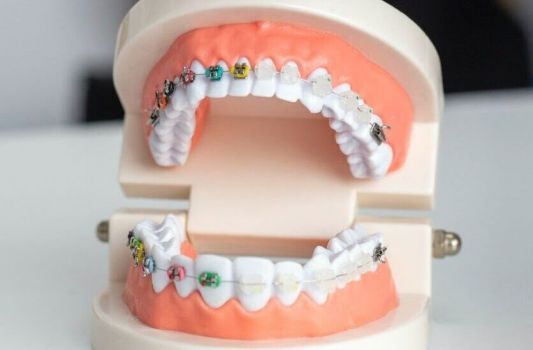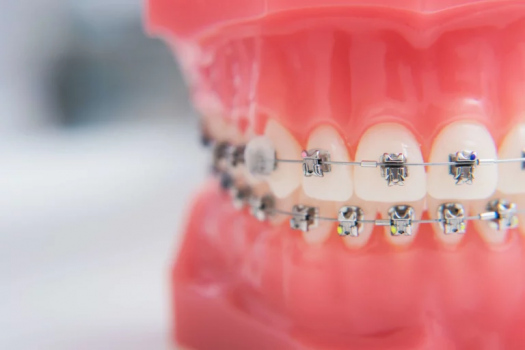Four Primary Types of Braces
Learn Which Will Work Best for You at a Consultation
Contemporary orthodontics offers more types of braces than ever before, and board-certified orthodontist Dr. Wint W. Tun will be happy to provide a no-obligation, no-cost consultation to discuss your needs and explain the cost of braces. Treatment options increase as a patient ages. While traditional braces require fixed brackets of metal or ceramic, in some cases patients can opt for clear braces or Invisalign clear, removable aligners.
Generally, braces move teeth to correct malocclusion, spacing or crowding issues, and crooked teeth. Sometimes braces are worn in combination with adjunct appliances, like space maintainers, palatal expanders, and fixed CL II correctors ( Herbst, Powerscope, etc.), to name a few. Braces can improve the appearance, health, and function of a person’s smile.
Let’s explore the four main types of braces and what each accomplishes:

Traditional Braces
Traditional Braces
Comprised of brackets, wires, and elastics, traditional braces correct malocclusion by allowing for unrestricted tooth movement. The gentle, consistent forces applied to the brackets cause the bone to soften as teeth roots move toward ideal alignment. Traditional braces treat cases of all complexities.
Usually, orthodontic therapy with traditional braces takes about two years and is appropriate for children as young as seven years old. Phase one, or early orthodontics, is often performed with limited traditional braces. Kids can wear colorful elastics to make braces more fun!
Adults with complex orthodontic cases may require traditional braces instead of other options.
To comply with treatment, a patient with traditional braces is responsible for cleaning his or her teeth after meals, avoiding certain types of foods, and getting regular checkups and cleanings with his general dentist. In addition, patients will need to attend check-in visits at our office every four to six weeks, as scheduled. Compliance with these responsibilities will ensure the patient remains on track to complete traditional braces treatment on time.
Traditional braces cost less than other options, in most cases. Learn more about the cost of braces.

Invisalign
Invisalign
A revolutionary orthodontic therapy, Invisalign’s clear acrylic aligners, are virtually invisible and can be removed during special events, while enjoying a meal, and for cleaning your teeth and aligners. Like other types of braces, Invisalign uses gentle, consistent force to push teeth into proper alignment.
As a certified Invisalign orthodontist, Dr. Wint W. Tun will take scans of your teeth and use special software to create your custom treatment plan. Then, an offsite Invisalign lab will fabricate a series of aligners for your entire treatment plan. Every two weeks, you’ll discard your current aligner and use the next one. In most cases, Invisalign treatment takes nine to 18 months, rather than 24 months.
We also offer Invisalign Teen and Invisalign First, which come with a set number of free replacement aligners, because kids and teens tend to lose aligners (and retainers).

Clear Braces
Clear Braces
Image-conscious adults who don’t want to wear the obvious metal brackets of traditional braces can opt for “clear braces”. The mechanics, components, results, and treatment time for clear braces are consistent with traditional braces. Adults with cases too complex for Invisalign treatment often choose clear braces.
Clear braces aren’t actually see-through, but they’re made of white ceramic that blends with tooth enamel for an extremely inconspicuous look. Because ceramic is more fragile than metal, we usually recommend clear braces for top teeth only.

Self-Ligating Braces
Self-Ligating Braces
The difference between traditional braces and self-ligating braces has to do with the brackets. Traditional brackets rely on elastics or metal ties (ligatures) to hold the archwire in place. Instead, self-ligating brackets feature a built-in clip (or small doors) that allows the archwire to slide.
The primary benefits of self-ligating braces are shorter orthodontist visits and easier cleaning. One study, however, found that surveyed patients experienced less soreness with self-ligating braces.
Learn Which Type of Braces Is Right for You
Call Harmony Orthodontics in Tomball, TX, at 832-699-3686 to schedule your complimentary consultation with Dr. Wint W. Tun to learn which type of braces will accomplish your goals. Our bright, comfortable office serves patients of all ages, and we’re accepting new patients today!